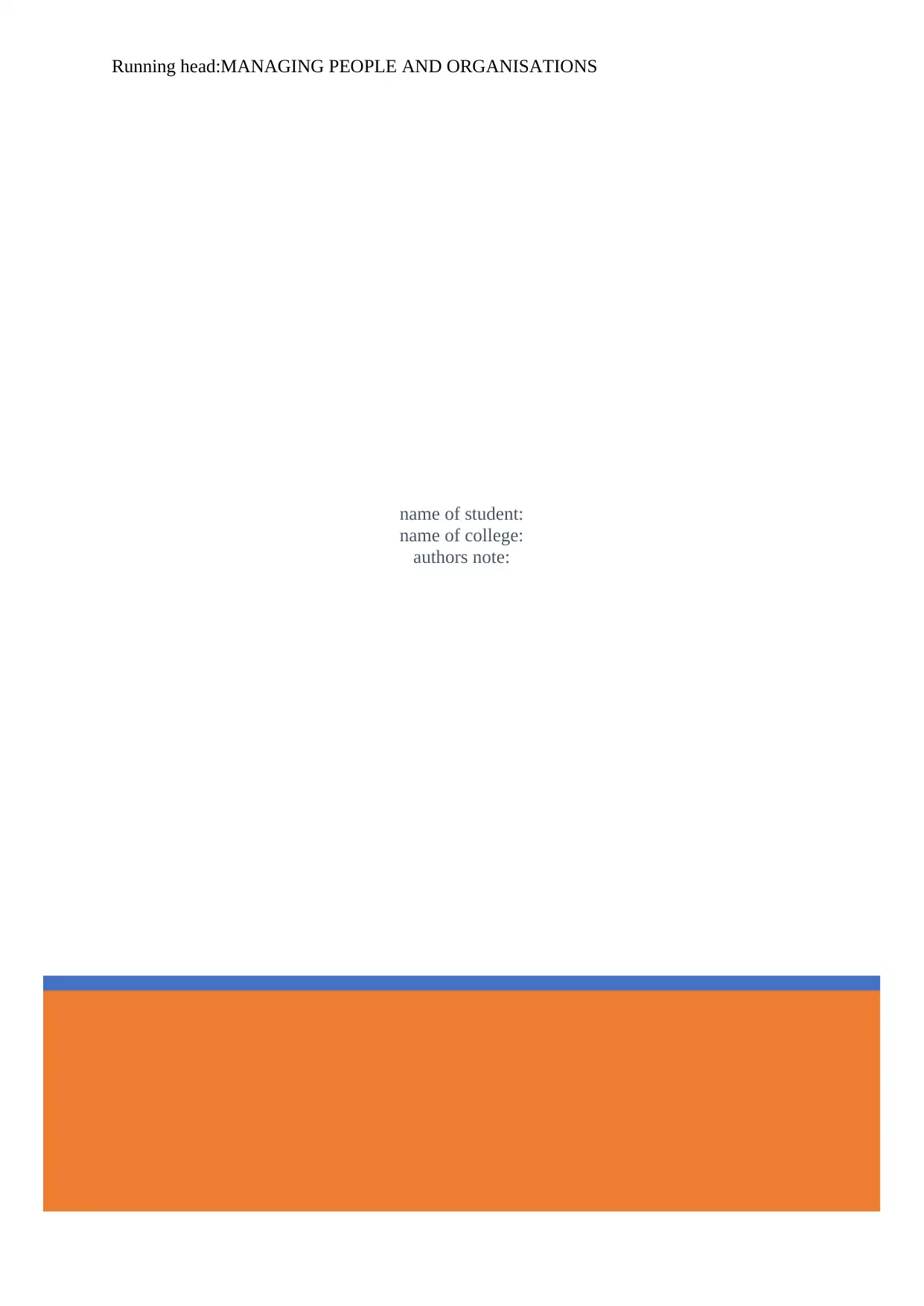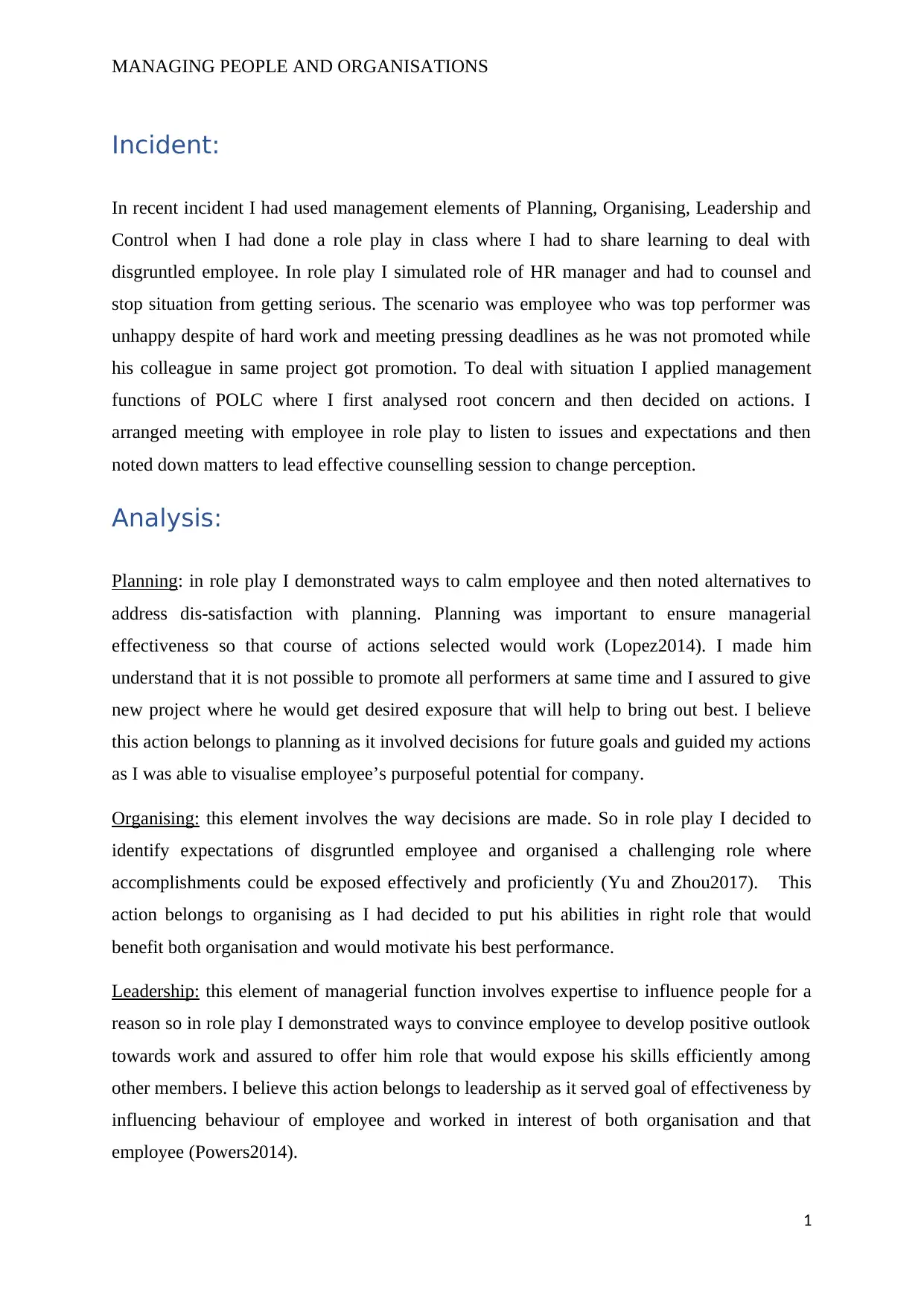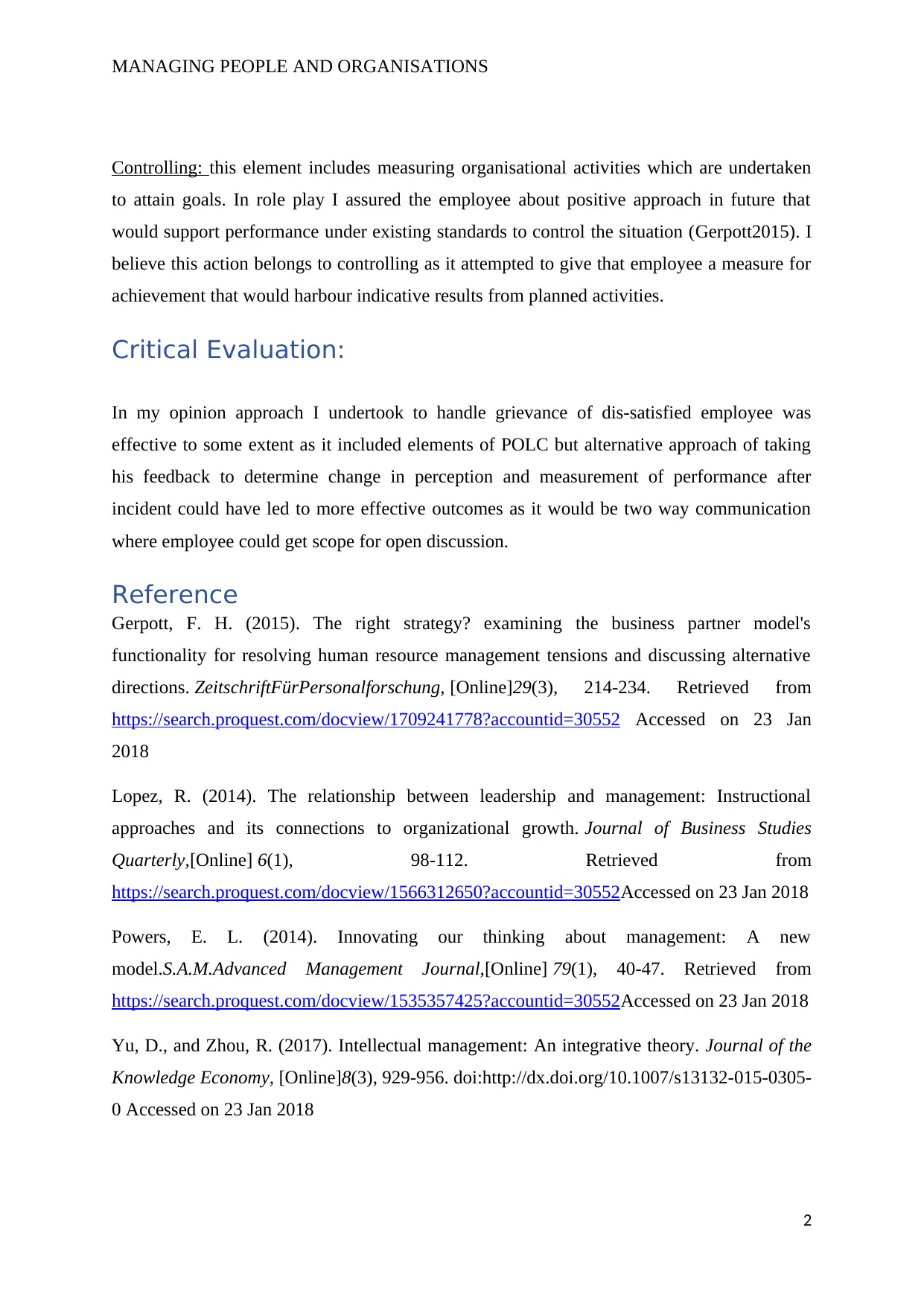Analysis of Management Functions (POLC) in an HR Incident
VerifiedAdded on 2023/04/22
|3
|754
|279
Report
AI Summary
This report presents an analysis of an incident where the student applied the POLC (Planning, Organizing, Leadership, and Controlling) management functions. The incident involved an HR scenario with a disgruntled employee, and the student, acting as an HR manager, used the POLC framework to address the situation. The report breaks down the incident, explaining how each management function was utilized. The student reflects on the effectiveness of their approach, evaluating the strengths and weaknesses of their actions and suggesting improvements. The analysis includes specific examples of how planning, organizing, leadership, and controlling were implemented, along with a critical evaluation of the overall strategy. References are provided to support the analysis.

name of student:
name of college:
authors note:
Running head:MANAGING PEOPLE AND ORGANISATIONS
name of college:
authors note:
Running head:MANAGING PEOPLE AND ORGANISATIONS
Paraphrase This Document
Need a fresh take? Get an instant paraphrase of this document with our AI Paraphraser

MANAGING PEOPLE AND ORGANISATIONS
Incident:
In recent incident I had used management elements of Planning, Organising, Leadership and
Control when I had done a role play in class where I had to share learning to deal with
disgruntled employee. In role play I simulated role of HR manager and had to counsel and
stop situation from getting serious. The scenario was employee who was top performer was
unhappy despite of hard work and meeting pressing deadlines as he was not promoted while
his colleague in same project got promotion. To deal with situation I applied management
functions of POLC where I first analysed root concern and then decided on actions. I
arranged meeting with employee in role play to listen to issues and expectations and then
noted down matters to lead effective counselling session to change perception.
Analysis:
Planning: in role play I demonstrated ways to calm employee and then noted alternatives to
address dis-satisfaction with planning. Planning was important to ensure managerial
effectiveness so that course of actions selected would work (Lopez2014). I made him
understand that it is not possible to promote all performers at same time and I assured to give
new project where he would get desired exposure that will help to bring out best. I believe
this action belongs to planning as it involved decisions for future goals and guided my actions
as I was able to visualise employee’s purposeful potential for company.
Organising: this element involves the way decisions are made. So in role play I decided to
identify expectations of disgruntled employee and organised a challenging role where
accomplishments could be exposed effectively and proficiently (Yu and Zhou2017). This
action belongs to organising as I had decided to put his abilities in right role that would
benefit both organisation and would motivate his best performance.
Leadership: this element of managerial function involves expertise to influence people for a
reason so in role play I demonstrated ways to convince employee to develop positive outlook
towards work and assured to offer him role that would expose his skills efficiently among
other members. I believe this action belongs to leadership as it served goal of effectiveness by
influencing behaviour of employee and worked in interest of both organisation and that
employee (Powers2014).
1
Incident:
In recent incident I had used management elements of Planning, Organising, Leadership and
Control when I had done a role play in class where I had to share learning to deal with
disgruntled employee. In role play I simulated role of HR manager and had to counsel and
stop situation from getting serious. The scenario was employee who was top performer was
unhappy despite of hard work and meeting pressing deadlines as he was not promoted while
his colleague in same project got promotion. To deal with situation I applied management
functions of POLC where I first analysed root concern and then decided on actions. I
arranged meeting with employee in role play to listen to issues and expectations and then
noted down matters to lead effective counselling session to change perception.
Analysis:
Planning: in role play I demonstrated ways to calm employee and then noted alternatives to
address dis-satisfaction with planning. Planning was important to ensure managerial
effectiveness so that course of actions selected would work (Lopez2014). I made him
understand that it is not possible to promote all performers at same time and I assured to give
new project where he would get desired exposure that will help to bring out best. I believe
this action belongs to planning as it involved decisions for future goals and guided my actions
as I was able to visualise employee’s purposeful potential for company.
Organising: this element involves the way decisions are made. So in role play I decided to
identify expectations of disgruntled employee and organised a challenging role where
accomplishments could be exposed effectively and proficiently (Yu and Zhou2017). This
action belongs to organising as I had decided to put his abilities in right role that would
benefit both organisation and would motivate his best performance.
Leadership: this element of managerial function involves expertise to influence people for a
reason so in role play I demonstrated ways to convince employee to develop positive outlook
towards work and assured to offer him role that would expose his skills efficiently among
other members. I believe this action belongs to leadership as it served goal of effectiveness by
influencing behaviour of employee and worked in interest of both organisation and that
employee (Powers2014).
1

MANAGING PEOPLE AND ORGANISATIONS
Controlling: this element includes measuring organisational activities which are undertaken
to attain goals. In role play I assured the employee about positive approach in future that
would support performance under existing standards to control the situation (Gerpott2015). I
believe this action belongs to controlling as it attempted to give that employee a measure for
achievement that would harbour indicative results from planned activities.
Critical Evaluation:
In my opinion approach I undertook to handle grievance of dis-satisfied employee was
effective to some extent as it included elements of POLC but alternative approach of taking
his feedback to determine change in perception and measurement of performance after
incident could have led to more effective outcomes as it would be two way communication
where employee could get scope for open discussion.
Reference
Gerpott, F. H. (2015). The right strategy? examining the business partner model's
functionality for resolving human resource management tensions and discussing alternative
directions. ZeitschriftFürPersonalforschung, [Online]29(3), 214-234. Retrieved from
https://search.proquest.com/docview/1709241778?accountid=30552 Accessed on 23 Jan
2018
Lopez, R. (2014). The relationship between leadership and management: Instructional
approaches and its connections to organizational growth. Journal of Business Studies
Quarterly,[Online] 6(1), 98-112. Retrieved from
https://search.proquest.com/docview/1566312650?accountid=30552Accessed on 23 Jan 2018
Powers, E. L. (2014). Innovating our thinking about management: A new
model.S.A.M.Advanced Management Journal,[Online] 79(1), 40-47. Retrieved from
https://search.proquest.com/docview/1535357425?accountid=30552Accessed on 23 Jan 2018
Yu, D., and Zhou, R. (2017). Intellectual management: An integrative theory. Journal of the
Knowledge Economy, [Online]8(3), 929-956. doi:http://dx.doi.org/10.1007/s13132-015-0305-
0 Accessed on 23 Jan 2018
2
Controlling: this element includes measuring organisational activities which are undertaken
to attain goals. In role play I assured the employee about positive approach in future that
would support performance under existing standards to control the situation (Gerpott2015). I
believe this action belongs to controlling as it attempted to give that employee a measure for
achievement that would harbour indicative results from planned activities.
Critical Evaluation:
In my opinion approach I undertook to handle grievance of dis-satisfied employee was
effective to some extent as it included elements of POLC but alternative approach of taking
his feedback to determine change in perception and measurement of performance after
incident could have led to more effective outcomes as it would be two way communication
where employee could get scope for open discussion.
Reference
Gerpott, F. H. (2015). The right strategy? examining the business partner model's
functionality for resolving human resource management tensions and discussing alternative
directions. ZeitschriftFürPersonalforschung, [Online]29(3), 214-234. Retrieved from
https://search.proquest.com/docview/1709241778?accountid=30552 Accessed on 23 Jan
2018
Lopez, R. (2014). The relationship between leadership and management: Instructional
approaches and its connections to organizational growth. Journal of Business Studies
Quarterly,[Online] 6(1), 98-112. Retrieved from
https://search.proquest.com/docview/1566312650?accountid=30552Accessed on 23 Jan 2018
Powers, E. L. (2014). Innovating our thinking about management: A new
model.S.A.M.Advanced Management Journal,[Online] 79(1), 40-47. Retrieved from
https://search.proquest.com/docview/1535357425?accountid=30552Accessed on 23 Jan 2018
Yu, D., and Zhou, R. (2017). Intellectual management: An integrative theory. Journal of the
Knowledge Economy, [Online]8(3), 929-956. doi:http://dx.doi.org/10.1007/s13132-015-0305-
0 Accessed on 23 Jan 2018
2
⊘ This is a preview!⊘
Do you want full access?
Subscribe today to unlock all pages.

Trusted by 1+ million students worldwide
1 out of 3
Related Documents
Your All-in-One AI-Powered Toolkit for Academic Success.
+13062052269
info@desklib.com
Available 24*7 on WhatsApp / Email
![[object Object]](/_next/static/media/star-bottom.7253800d.svg)
Unlock your academic potential
Copyright © 2020–2025 A2Z Services. All Rights Reserved. Developed and managed by ZUCOL.





